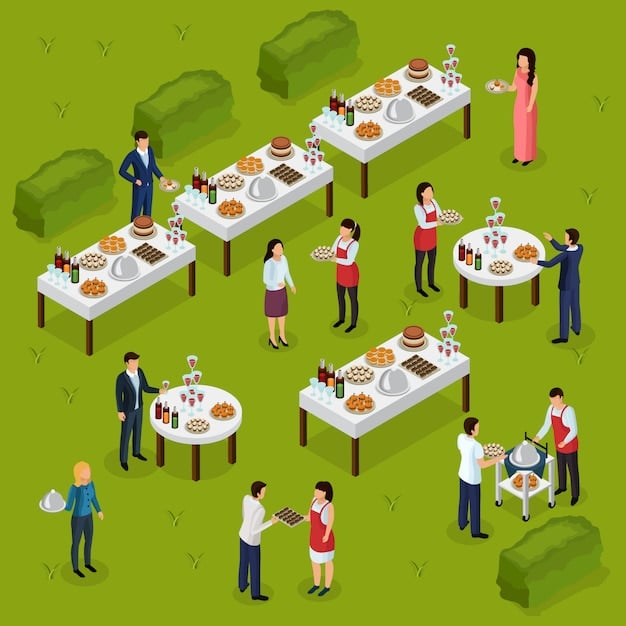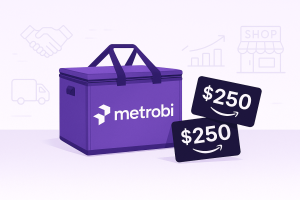The cold truth? Most event catering fails before the first appetizer is served. Not because of the food quality, but because of poor catering setup planning. After working with hundreds of event planners and caterers across the country, I’ve seen brilliant menu concepts fall apart due to simple layout mistakes and equipment issues that could have been avoided during food prep.
Picture this: Your team is scrambling between crowded tables, guests are waiting in frustrating line formations near serving stations, and food temperatures are dropping by the minute. Meanwhile, that carefully crafted budget? It’s bleeding money with every passing hour, impacting the business side of your company.
What if I told you that the difference between catering chaos and seamless service comes down to just five strategic decisions you can decide upon before any event? Understanding the details of the venue and room is key.
The most successful event-based businesses don’t just serve delicious food—they create systems designed to run smoothly, even when things go wrong. They know how to manage their resources. And contrary to what many believe, these systems aren’t complex or expensive to implement; sometimes, you just need to opt for smarter choices.
In my 15 years of event planning, I’ve found that catering success follows a simple pattern: smart equipment choices, thoughtful space design (including the floor plan), and budget optimization that doesn’t sacrifice quality but helps you save money. We need to prepare thoroughly for the big day.
Today, I’m sharing the exact Smart Catering Setup Strategies that have helped my clients handle everything from intimate gatherings to 500-person corporate events without breaking a sweat. We’ll look at a specific example later.
These techniques will transform how you approach your next event—whether you’re a seasoned caterer or just starting out. They’re practical, tested, and surprisingly simple to implement, covering everything from hiring staff to the final clearing of plates.
Ready to turn your next catering operation from a stress test into a showcase of your professional expertise?
Boost customer satisfaction with just a few clicks
Most-Loved Features:
- On-demand drivers
- Real-time GPS tracking
- Delivery confirmation photos
- Over 50% of customers report a smoother delivery experience
Step 1: Mastering Catering Equipment Optimization
Strategic inventory planning prevents last-minute emergencies
Multipurpose tools reduce setup time and transportation costs
Equipment forms the backbone of any successful catering operation. The right tools in the right quantities make the difference between smooth service and chaotic scrambling. Equipment optimization starts with thoughtful assessment and ends with strategic selection of versatile items that serve multiple purposes.
1.1 Assess Your Equipment Needs for Specific Events like Corporate Events
Every catering event begins with an honest evaluation of what you have and what you’ll need. Start by creating a detailed inventory of all available equipment. This isn’t simply counting items – it’s about understanding their condition, functionality, and appropriateness for the upcoming event.
“Investing in the best catering supplies and equipment is crucial for the success of any food business. Having the right tools can make a significant difference in the efficiency, reliability, and overall quality of your operations,” notes catering supply experts at Metrobi.
When assessing equipment needs, consider three critical factors: event size, menu requirements, and venue limitations. A corporate lunch for 50 guests requires different equipment than a wedding reception for 200. Similarly, a cold buffet has different demands than a plated hot meal service.
Create a checklist organized by categories: cooking equipment, serving tools, food storage, tableware, and transport containers. For each item, determine the quantity needed based on guest count and service style.
Matching Equipment to Event Requirements
Different events call for different equipment setups. Understanding the specific needs of each event type saves time and prevents bringing unnecessary items. For formal plated dinners, you’ll need plate covers, serving trays, and formal serviceware. For casual buffets, focus on chafing dishes, serving utensils, and food shields.
When determining equipment needs for a specific event, start by breaking down your menu into preparation stages (cold prep, cooking, holding, serving) and identify the equipment required for each stage. Next, check if your venue provides any equipment that can supplement your inventory. Many venues offer tables, chairs, and basic kitchen facilities.
Finding the right balance begins with clear communication with clients about their expectations for food presentation and service style.
1.2 Consider Versatile Equipment
Smart caterers prioritize multipurpose equipment that can handle various tasks. This approach reduces the total number of items to transport, set up, and manage during an event, leading to significant time and cost savings.
“Why stick to single-use serving equipment when there are versatile options out there? Versatile equipment that can be used for different dishes or presentations can be a game-changer for catering businesses. This versatility not only limits the total number of items to transport and set up but also reduces storage needs,” according to industry experts.
Combi ovens represent one of the best investments for versatility. These units combine convection and steam cooking functions, allowing you to prepare different menu items simultaneously while maintaining quality. Similarly, induction cooktops offer precise temperature control and can be used for cooking, warming, or holding food.
For serving, consider modular buffet systems with interchangeable components that can be configured in multiple ways. These systems often include adaptable risers, platforms, and holders that transform to suit different food presentations. Melamine serveware that mimics the appearance of ceramic or porcelain while offering durability and lighter weight provides another versatile option.
Strategic Equipment Investments
Investing in high-quality, versatile equipment pays dividends over time. Commercial-grade tools might cost more initially but offer extended durability and better performance. “Using quality, commercial-grade equipment can make a big difference in any catering kitchen, helping to cut costs and boost staff efficiency,” notes Boelter, a leading food service equipment provider.
When considering new equipment purchases, evaluate each item based on:
Frequency of use across different event types
Versatility and adaptability to different menus
Space requirements for storage and transport
Energy efficiency and operational costs
Ease of cleaning and maintenance
One often overlooked aspect of equipment selection is standardization. When components work together as a system, staff training simplifies, setup speeds increase, and the risk of compatibility issues decreases. For example, choosing serving dishes that nest together saves storage space and standardizing on specific pan sizes ensures lids and covers are interchangeable.
For caterers working with limited budgets, a gradual investment approach works best. Begin with versatile essentials that serve multiple functions, then slowly add specialized equipment as your business grows. Many caterers find success by partnering with rental companies for rarely-used specialty items.
When organizing a catering event, proper equipment organization becomes the foundation of success. Professional caterers typically include six key elements in their proposals: menu details, staffing plans, equipment lists, timeline, pricing structure, and cancellation policies. Understanding these components helps with comprehensive planning.
For those wondering about catering for 100 guests on a budget, equipment optimization offers significant savings. Focus on buffet-style service with fewer staff requirements and rent specialized equipment instead of purchasing. Select menu items that can be prepared with minimal equipment and served at room temperature to reduce heating and cooling needs.
When pricing services, factor in equipment depreciation, transport, setup/breakdown time, and potential replacement costs for damaged items.
With thoughtful equipment planning and selection of versatile tools, your catering operation will run more efficiently while delivering exceptional guest experiences. The foundation you establish through proper equipment optimization supports every other aspect of your event execution.
Step 2: Implementing Efficient Event Layout Design in Your Event Space
Proper traffic flow prevents bottlenecks and improves guest satisfaction
Strategic station placement maximizes staff efficiency and guest comfort
2.1 Analyze Venue Layout
The foundation of an efficient catering setup begins with a careful analysis of your venue space. This critical first step can make or break your event flow. Start by requesting detailed floor plans from the venue at least 2-4 weeks before the event. These should include exact measurements, existing fixtures, power outlet locations, and any permanent features that cannot be moved.
When you first arrive at the venue, walk the entire space with the floor plan in hand. Note any discrepancies between the plan and the actual space. Pay close attention to ceiling height, which affects temperature control and sound, and floor material, which impacts staff mobility and equipment stability. Take photos from multiple angles for later reference during planning sessions with your team.
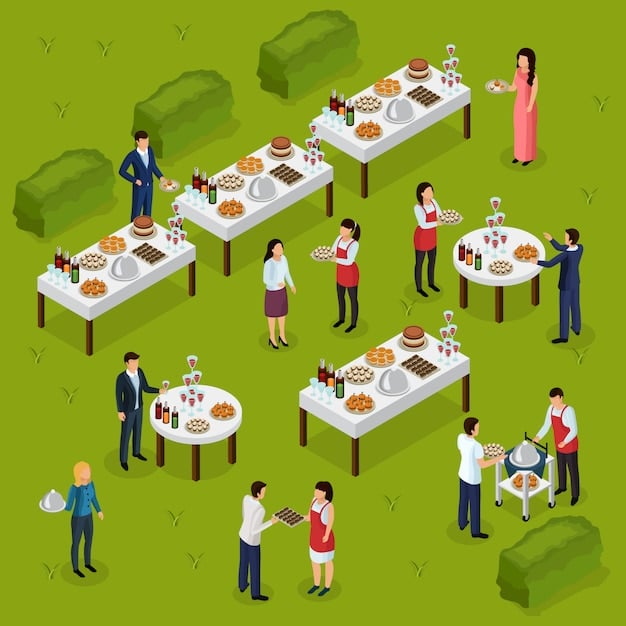
Creating Floor Plan Schematics
Create a scaled schematic of the venue using either specialized event planning software or simple graph paper. Mark all fixed elements first: columns, exits, bathrooms, existing tables, and electrical outlets. Allow at least 36 inches for all walkways to comply with most local fire codes and accessibility requirements. For seated events, the standard is 60 inches between tables to allow service staff to move freely.
Office Catering Market Growth Projection: The Food at Work (B2B office catering) sector is projected to grow at an 8.8% CAGR between 2023 and 2030.
This growth means more competition and higher guest expectations for smooth event experiences, making efficient layout design increasingly important.
Strategic Station Placement
When determining the placement of food stations and bars, consider both practical and experiential factors. Food stations should be positioned away from the main traffic paths but still accessible from multiple directions. The ideal layout prevents lines from forming in ways that block movement through the venue.
For buffet-style service, plan for double-sided access when possible, allowing twice as many guests to serve themselves simultaneously. Position food stations around the perimeter of the room rather than in the center to maximize open floor space and improve flow. For stations requiring power, ensure they’re near outlets or plan for cord management that won’t create tripping hazards.
2.2 Ensure Easy Access for Staff and Guests
Creating separate pathways for staff and guests enhances both service efficiency and the event experience. Your staff needs direct routes to key service areas without navigating through guest spaces whenever possible. Start by identifying your main service hub—typically your prep area or mobile kitchen—and create clear, direct paths to all food and beverage stations.
For staff access, establish service corridors at least 30 inches wide. Mark these paths with subtle floor indicators visible to staff but not distracting to guests. If possible, create a “back of house” area using portable screens or existing venue features to shield prep work from guest view. Position trash and bussing stations strategically at the endpoints of these service paths, away from guest sight lines but easily accessible for staff.
Managing Guest Traffic Flow
Guest movement patterns require careful planning to prevent bottlenecks. The most common bottlenecks occur at entrances, bar areas, and popular food stations. Position greeting or check-in tables at least 10 feet inside the entrance to prevent crowds from forming outside. For events with more than 50 guests, create multiple entry points to distribute arriving guests more evenly.
Bars typically generate the longest wait times. Position bars against walls or in corners with space for lines to form without blocking main pathways. For events with over 100 guests, consider multiple smaller bar stations instead of one large bar to distribute traffic.
Creating Intuitive Navigation
Guests should be able to navigate your event space without feeling confused or crowded. Use visual cues like directional signage, lighting, and physical elements to guide movement. Place high-demand stations (like the bar or popular food items) in separate areas to distribute crowds throughout the space.
For clarity, use consistent signage throughout the venue. Signs should be positioned at eye level (approximately 5 feet from the floor) and be visible from at least 20 feet away. Color-code different types of stations for easy identification—for example, blue for beverages, red for hot food, green for cold food. This visual system helps guests navigate more efficiently without constant questions to your staff.
2.3 Optimize Buffer Zones and Waiting Areas
Buffer zones are essential but often overlooked elements in catering layouts. These are spaces designed to absorb overflow from high-traffic areas. For every food station, allocate at least 36 square feet of buffer space where guests can stand comfortably while waiting or after receiving their food.
Plan waiting areas with both standing and seating options. These areas should have clear sightlines to the stations they serve so guests can monitor their place in line without physically standing in it.
Accessibility Considerations
An efficient layout must be accessible to all guests. Plan for wheelchair access to all food and beverage stations with ramps where needed. All service counters should include a section no higher than 34 inches from the floor to accommodate wheelchair users. Main pathways should be at least 36 inches wide, with turning spaces of 60 inches by 60 inches at key points.
Consider sensory needs as well by creating quiet zones away from speakers and high-traffic areas. These spaces benefit guests who may feel overwhelmed by crowded or noisy environments. Label these areas clearly on your event map and train staff to direct guests to them when requested.
2.4 Implement Flexible Layouts for Changing Needs
Events rarely unfold exactly as planned, so build flexibility into your layout. Using modular furniture and equipment allows for quick reconfigurations if needed. Select movable tables, portable bars, and lightweight partitions that can be repositioned with minimal effort.
Identify pivot points in your layout where adjustments might be needed. For example, if weather forces an outdoor area to close, have a backup plan for redirecting those stations indoors. Document these contingency plans with simple diagrams that staff can reference quickly during the event.
Testing and Refining Your Layout
Before the event, conduct a walkthrough with key staff members to test the flow of your layout. Have team members role-play as both servers and guests, moving through the space as they would during the actual event. Time how long it takes to move between key points and adjust your layout to resolve any bottlenecks or inefficiencies.
This highlights how the physical experience—largely determined by your layout—directly impacts client satisfaction and brand perception.
During this testing phase, practice critical scenarios such as emergency evacuations, spill responses, and service recovery situations. Ensure that all staff understand how to maintain service flow while addressing these challenges.
2.5 Document and Communicate Your Layout Plan
Once finalized, document your layout in multiple formats for different stakeholders. Create detailed floor plans for venue staff and your setup team, simplified maps for servers focusing on their specific stations, and guest-friendly maps for event programs or digital displays.
Hold a pre-event briefing with all staff members at least one hour before guests arrive. Walk the entire team through the space, pointing out key features, service paths, and potential challenge areas. Assign zone captains responsible for maintaining flow in specific sections of the venue throughout the event.
Monitoring and Adjusting During the Event
Even the best-planned layouts sometimes need adjustment during an event. Designate one team member as the “flow manager” whose primary responsibility is monitoring traffic patterns and addressing bottlenecks as they form. This person should have authority to redirect staff or reposition mobile elements as needed.
Establish clear hand signals or communication methods for staff to alert managers to flow problems without alarming guests. For example, a specific hand gesture could indicate that a station is becoming overwhelmed and needs additional support. These subtle communications maintain the guest experience while addressing operational needs.
By implementing these detailed layout strategies, your catering operation will run more smoothly, allowing both staff and guests to navigate the event with ease. Proper layout design sets the foundation for the service elements and budget strategies that follow in your catering plan.
Step 3: Leveraging Budget-Friendly Catering Solutions on the Business Side
Smart menu choices with seasonal ingredients cut costs without sacrificing quality
Rental strategies save money on rarely-used equipment
Reusable items reduce waste and long-term expenses
3.1 Optimal Menu Planning
Menu planning is the foundation of cost-effective catering. Your food choices directly impact your bottom line.
Popular Menu Requests: 50% of catering business owners surveyed report that barbecue/grilled food is the most requested menu item.
Start by examining what’s in season. Seasonal ingredients cost less and taste better. In spring, focus on asparagus, peas, and strawberries. Summer brings tomatoes, corn, and berries. Fall offers squash, apples, and root vegetables. Winter features citrus, hearty greens, and storage crops. Check local farmers’ markets or wholesalers for the best seasonal deals in your area.
Next, build menus with common ingredients across multiple dishes. This approach reduces waste and simplifies purchasing. For example, if you’re serving chicken as a main course, use chicken stock in your soup and chicken trimmings in a pasta dish.
Creating Cost-Effective Menu Templates
Develop a set of menu templates based on seasons and price points. Start with 3-4 base templates that you can adjust for specific events. Each template should include:
Appetizer options (2-3 choices)
Main dishes (2-3 options at different price points)
Side dishes that complement multiple mains
Dessert options that utilize similar base ingredients
“Smart menu planning and portion control further maximize value,” note industry experts. This means carefully calculating portions to avoid overordering while ensuring guests are satisfied.
Bulk Purchasing and Ingredient Maximization
Form relationships with local suppliers for better pricing on bulk items. Items with long shelf lives like grains, oils, and certain spices can be purchased in larger quantities.
For each ingredient, create a “waste reduction” plan:
Identify all possible uses for each ingredient
Plan secondary dishes using leftover components
Create a “cross-utilization” chart showing which ingredients appear in multiple dishes
Track actual usage to refine future purchasing
Consider creating a signature item that uses affordable ingredients but presents well. This could be a local specialty or a unique twist on a classic dish that sets your catering apart without breaking the bank.
3.2 Reusables and Rentals
Smart catering businesses know when to buy, rent, or repurpose equipment. Efficient resource management is crucial for competitive pricing.
Strategic Equipment Rental Plans
Analyze your event schedule to identify infrequently used equipment. Items used less than once a month are often better rented than purchased. Create a rental decision matrix by:
Listing all equipment you might need throughout the year
Marking frequency of use (weekly, monthly, quarterly)
Calculating purchase cost versus rental cost over 12 months
Factoring in storage, maintenance, and transportation costs
Equipment perfect for rental includes:
Specialty cooking equipment (smokers, large roasters)
Unusual serving pieces (chocolate fountains, carving stations)
Event-specific items (champagne towers, themed decor elements)
Large-capacity items used only for major events
Develop relationships with 2-3 reliable rental companies. Compare their pricing at least twice yearly. Ask about package deals or loyalty discounts for regular customers. Some rental companies offer reduced rates for weekday events or longer rental periods.
“From buffet-style meals to DIY food stations, cost-effective solutions allow hosts to impress guests without breaking the bank,” industry experts point out. These setups often involve renting equipment rather than purchasing it outright.
Implementing Reusable Solutions
Reusable items deliver long-term cost savings and environmental benefits. The initial investment might be higher than disposables, but the per-use cost drops significantly over time.
Start by investing in high-quality basics:
Durable serving platters and bowls in neutral colors
Standard glassware (water glasses, wine glasses)
Basic flatware sets
Cloth napkins in versatile colors
Calculate the break-even point for each reusable item compared to disposables:
Determine the cost of the reusable item
Calculate the per-use cost of disposable alternatives
Divide the reusable cost by the disposable cost to find how many uses before savings begin
Factor in cleaning and storage costs
To maximize the lifespan of reusable items:
Create a proper storage system with protective cases
Train staff on handling and cleaning procedures
Implement inventory tracking to reduce loss
Schedule regular maintenance checks
For special events, consider hybrid solutions. Use your reusable inventory for the core service and supplement with rentals for unique requirements or exceptionally large groups.
Smart Transportation and Storage Solutions
The logistics of moving reusable items between venues can impact their practicality. Design your storage and transportation systems to protect your investment:
Invest in stackable, durable storage containers
Label containers clearly with contents and quantities
Create loading diagrams for efficient vehicle packing
Use padding materials that can be reused (moving blankets, foam dividers)
“Establishing a clear budget, finding clever ways to save, and prioritizing quality over quantity can redefine hosting for the better,” according to catering experts. This philosophy applies perfectly to reusable equipment decisions.
Track the condition of all reusable items after each event. Create a replacement schedule based on typical wear patterns.
3.3 Scaling Your Service Style Models
Different service styles have varying cost implications. Understanding these differences helps you offer options at multiple price points.
Cost-Effective Service Models
From least to most expensive, typical service models include:
Drop-off service: Food delivered without service staff
Buffet service: Limited staff monitoring food stations
Family-style service: Food served in shareable platters at tables
Plated service: Individual plates served to each guest
For each event, present clients with service options and their associated costs. Many clients appreciate the transparency and ability to choose based on their priorities.
For budget-conscious clients, suggest hybrid models:
Passed appetizers with buffet main course
Family-style sides with plated entrées
Self-serve dessert stations after served meal
“Economical menus and meal planning for large groups made up of seasonal ingredients are also cost-effective,” note industry experts. Combine this approach with appropriate service models for maximum value.
When pricing your services, clearly itemize:
Food costs
Staff costs (including setup/breakdown time)
Equipment needs (purchased, owned, or rented)
Transportation expenses
Administrative overhead
This transparency helps clients understand what they’re paying for and makes it easier to adjust elements based on their budget.
Clients increasingly value catering partners who can deliver quality experiences at reasonable prices. By mastering budget-friendly solutions, you position your business for this expanding market.
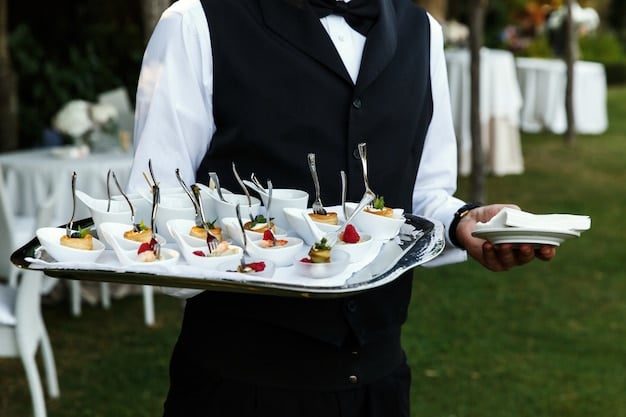
Advanced Tips for Streamlined Event Workflow Strategies
Digital tools transform event management by reducing manual tasks and tracking orders in real-time
Staggered preparation schedules prevent kitchen bottlenecks and ensure food quality
Preparing for common pitfalls saves time, money, and prevents day-of event disasters
Additional Advice and Alternative Methods
The foundation of successful event catering lies in implementing smart digital systems that track every aspect of your operation. Modern event management software does more than just organize your schedule—it creates a central hub for all your catering activities. These platforms allow real-time tracking of food orders, inventory levels, and staff assignments, reducing the mental load on managers during high-pressure events.
The tangible benefits include eliminating duplicated efforts and reducing human error, which often causes significant delays during events. For example, when tracking guest preferences and dietary restrictions, digital systems can instantly flag allergens and communicate them to the kitchen staff without the usual game of telephone that leads to mistakes.
Staggered preparation and serving times represent another game-changing approach to event catering. Rather than preparing all dishes simultaneously, professional caterers now schedule production in carefully timed waves. This method prevents kitchen bottlenecks and ensures food is served at its peak quality. A practical application is creating a detailed timeline that breaks down each dish by preparation stage, cooking time, and holding capacity. For instance, schedule cold appetizers for production 2-3 hours before the event, hot appetizers 1-2 hours before, and entrées to finish cooking just 15-30 minutes before service.
Implementing Digital Solutions for Real-Time Tracking
When selecting digital management tools, focus on platforms specifically designed for catering operations rather than general event management software. Tools like CaterZen, Total Party Planner, and Better Cater offer specialized features including recipe scaling, ingredient-level inventory management, and staff scheduling aligned with food production needs.
The implementation process requires an initial time investment but pays enormous dividends. Begin with a digital asset inventory by photographing and cataloging all equipment. Create standardized digital recipes with precise portion sizes and preparation times. Connect inventory management to your ordering system to generate automatic purchasing alerts when supplies run low.
This improvement directly translates to catering operations, where workflow automation reduces the administrative burden and allows focus on food quality and guest experience.
Common Pitfalls and How to Avoid Them
Last-minute menu changes represent one of the most disruptive challenges in event catering. When clients request significant alterations days before an event, the ripple effects impact purchasing, staffing, equipment needs, and production schedules. To prevent this scenario, implement a clear change policy with deadline dates prominently displayed in contracts.
Create tiered cutoff points: major menu changes (30+ days before), moderate adjustments (14-29 days), and minor tweaks (7-13 days). After the final cutoff date, only accommodate changes that require minimal additional resources. When presenting menus to clients, provide detailed descriptions and photo references of each dish to prevent misunderstandings about what they’re ordering, which often leads to last-minute change requests.
Stephen Covey offers relevant wisdom when he notes, “The key is not to prioritize what’s on your schedule, but to schedule your priorities.” This applies perfectly to menu planning—establish the non-negotiable aspects of your menu early, then build flexibility around those fixed points.
Unexpected guest increases represent another significant challenge for catering operations. Professional caterers prepare for this inevitability by building buffer capacity into every event. This covers unexpected additions and provides peace of mind for the client. For beverages, the buffer is typically higher, especially for alcohol service.
Beyond food quantity, prepare for guest increases by bringing extra place settings, service ware, and portable equipment. Train staff to implement “stretch plans” that modify service style if guest counts exceed a certain threshold. For example, a planned plated service might transition to elegant buffet stations if attendance exceeds capacity.
Creating Contingency Plans for Weather and Venue Issues
External factors like weather conditions and venue limitations frequently disrupt catering operations. Develop detailed contingency plans for outdoor events, including waterproof coverings for food stations, portable heating or cooling solutions for temperature-sensitive items, and backup power sources for essential equipment.
The experienced event planner Benjamin Franklin wisely noted, “By failing to prepare, you are preparing to fail.” This principle applies directly to catering operations where preparing for unlikely scenarios prevents catastrophic failures. Create a “day-of emergency kit” containing extra serving utensils, portable burners, extension cords, and basic repair tools. Designate a troubleshooting team member who remains free from regular service duties to address unexpected issues as they arise.
Optimizing Staff Management and Communication
Effective staff deployment represents a critical yet often overlooked aspect of streamlined catering operations. These ratios ensure proper coverage without unnecessary labor costs.
Variable Staffing Ratios By Service Style: Meal service levels can range from 1 server per 8 guests to 1 server per 40 guests, depending on service style.
Beyond numbers, strategic positioning of staff throughout the venue dramatically improves service flow. Station experienced team members at critical service points while placing newer staff in supporting roles. Implement the “zones of responsibility” method, where the venue is divided into clearly defined service areas with dedicated teams that maintain continuity throughout the event.
Buffet Staffing Guideline: A good rule of thumb is to plan for 1 server for every 3 chafing dishes at catering events.
Communication systems deserve special attention in busy event environments. Modern catering operations have moved beyond shouting across kitchens to sophisticated solutions like wireless earpieces and digital communication platforms. These systems allow instant coordination between front-of-house and kitchen teams without disrupting the guest experience.
“Whether you are spending too much time in repeating tedious manual tasks, such as program updating and speaker followups. You need a right axe. Recent event techs can help automate your tasks, so explore new options here,” notes Whova Event Tech Trends. This applies equally to staff coordination—technology bridges communication gaps without adding complexity.
Pre-Event Training and Briefing Protocols
Standardized pre-event briefings represent a hallmark of professional catering operations. Develop a consistent format that covers critical information in under 15 minutes: menu highlights, service timing, client priorities, venue specifics, and potential challenges. Conduct these briefings 90 minutes before guest arrival to allow staff to process information and ask questions before service begins.
Industry Focus On Staff Training: 61% of restaurant operators prioritized basic job skills training in 2025, a 25% increase from 2024.
Incorporate mini-training sessions for specific techniques required for each event. For example, if serving a particular wine with special decanting requirements or presenting a complex plated dish with precise garnish placement, demonstrate the technique during the briefing rather than assuming staff competency.
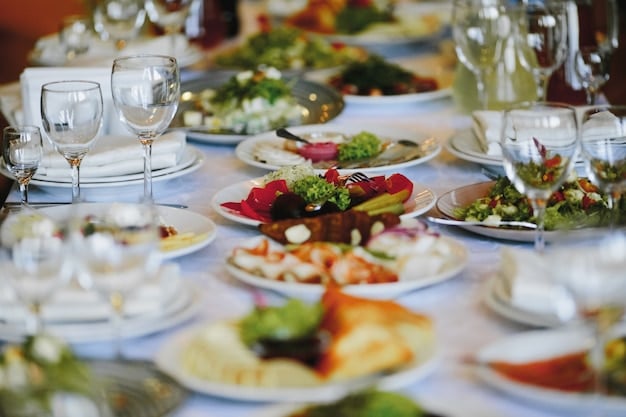
Incorporating Sustainable Practices into the Workflow
Sustainability initiatives not only reduce environmental impact but also streamline operations through reduced waste and improved resource utilization. Professional caterers now implement comprehensive food waste management systems that track preparation waste, plate waste, and unserved food to identify patterns and opportunities for improvement.
Global Economic Impact of Food Waste: The global economy loses around $1 trillion to food waste annually, encompassing wasted land, water, energy, and economic effects.
US Food Waste Scale: The U.S. wastes 92 billion pounds of food annually, equating to 145 billion meals and over $473 billion in value.
The traditional practice of overproduction “just in case” is being replaced by data-driven preparation quantities based on historical consumption patterns. Modern catering operations maintain detailed records of how much food different demographics actually consume at various event types, times of day, and service styles. This allows for precise production planning without excessive waste.
Donation programs for unserved food have evolved from casual arrangements to structured partnerships with local shelters and food recovery organizations. Establish relationships with these partners before events and create standard operating procedures for safe food handling, transportation, and documentation of donated items. These programs not only prevent waste but also generate goodwill and potential tax benefits.
This growth creates both opportunity and responsibility to implement sustainable practices at scale.
Enhancing Client Communication and Expectation Management
Clear communication protocols prevent misunderstandings that disrupt workflow. Professional caterers now implement structured communication timelines with standardized check-in points: contract signing, 30 days before, 14 days before, 7 days before, 48 hours before, and day-of confirmations. Each check-in covers specific topics and decisions required by that stage.
Digital platforms facilitate this process through automated reminders and standardized forms that clients complete at each stage. These systems ensure critical information is collected in a timely manner while creating documentary evidence of all decisions and approvals. For particularly detail-oriented clients, consider creating custom online portals where they can view their event details, make minor adjustments, and communicate with your team through a centralized platform.
The impact of effective client communication extends beyond operational efficiency—it directly affects marketing outcomes. When clients feel their needs are understood and met, they become powerful advocates for your services.
Further Resources and Reading
Books and courses to deepen your catering setup knowledge
Industry associations and communities for networking
Free tools to help implement what you’ve learned
Books and Professional Development Resources
The path to mastering event catering extends far beyond basic setups. Professional caterers constantly update their skills through reading, courses, and communities. Here are specific resources that will help you build on what you’ve learned so far.
For foundational knowledge, “The Professional Caterer’s Handbook” by Elizabeth Goodwin provides step-by-step guidance on equipment selection, layout planning, and budget management. It includes detailed checklists and templates you can adapt for your own events. Another valuable resource is “The Culinary Professional” by John Draz, which offers practical insights into food preparation workflows and station design.
For those seeking formal training, the International Caterers Association (ICA) offers certification programs specifically designed for event professionals. Their Certified Catering Executive (CCE) credential covers advanced topics in event logistics, staff management, and client communication. The National Restaurant Association’s ServSafe program also provides essential food safety certification that many clients now expect from professional caterers.
Online learning platforms like Coursera and Udemy offer flexible courses on event management. The “Event Planning and Management: Fundamentals” course by Michigan State University on Coursera provides a comprehensive overview of event planning principles with modules dedicated to catering operations.
Free Online Tools and Templates
Smart catering professionals leverage technology to streamline their operations. Several free tools can help you implement the strategies discussed throughout this article without significant investment.
For equipment inventory management, Sortly offers a free plan that lets you catalog items with photos, condition notes, and maintenance records. This visual inventory system makes it easier to plan what equipment you’ll need for upcoming events and identify gaps in your collection.
When designing event layouts, free tools like SmartDraw or Canva provide templates specifically for event spaces. These programs let you create professional floor plans showing equipment placement, guest flow, and staff movement paths. They’re particularly helpful when communicating your vision to venue staff or clients.
For budget tracking, Google Sheets offers free templates designed specifically for event planning. These include sections for equipment costs, food expenses, and staffing that you can customize to fit your specific operation. Many include formulas that calculate per-person costs automatically, making pricing more transparent for clients.
Mobile apps like Trello or Asana offer free versions that help coordinate staff assignments and track task completion during setup. Creating digital checklists ensures nothing gets missed during busy pre-event periods and helps train new staff consistently.
Case Studies and Real-World Applications
Learning from others’ experiences—both successes and failures—provides valuable shortcuts in improving your catering setups. Industry publications regularly feature case studies that demonstrate practical applications of the principles we’ve discussed.
Catering Magazine publishes monthly profiles of successful caterers, often highlighting their operational systems and equipment strategies. These detailed accounts include photos of actual event setups and explanations of why specific choices were made. Special Event Magazine regularly features “Event Style” sections showing innovative catering presentations and the logistics behind them.
Online platforms like TotalFoodService share video walkthroughs of catering kitchens and event setups, giving you a first-hand look at effective workflows. These visual guides are particularly helpful for understanding traffic flow and equipment placement concepts that might be difficult to grasp from written descriptions alone.
This growth means increasing competition and higher client expectations, making professional knowledge more valuable than ever.
Industry Associations and Community Forums
Connecting with fellow professionals through industry associations provides ongoing support and education. The International Caterers Association offers members access to research papers, operational templates, and a network of experienced professionals willing to share advice.
Catering Industry Staffing Structure: 37% of catering companies have between 1–10 full-time staff, and 82% have fewer than 50 full-time employees.
The Leading Caterers of America (LCA) maintains a knowledge base covering everything from equipment maintenance schedules to staff training protocols. Their members-only forum allows professionals to ask specific questions about equipment selection, layout challenges, or budget constraints and receive responses from experienced caterers.
Regional catering associations often provide more localized support, addressing challenges specific to your market. These groups typically host monthly meetings where members can discuss common issues and share solutions in a collaborative environment.
Online communities like the Catering Professionals group on LinkedIn or the r/Catering subreddit provide free forums to ask questions or share experiences. While advice from these sources should be evaluated carefully, they can provide quick answers to common problems or connect you with professionals who’ve faced similar challenges.
As event management expert Eddie Ross notes, “Good planning I’ve always thought is in the details…Plan it out, make it interesting, and you’re sure to pull it off!” This emphasis on detailed planning aligns perfectly with the systematic approach to catering setups we’ve discussed throughout this article.
Sustainability Resources and Guides
As clients increasingly prioritize environmental responsibility, resources focusing on sustainable catering practices have become essential. The Green Restaurant Association offers certification programs and practical guides for reducing food waste, minimizing energy use, and selecting environmentally responsible equipment.
The Sustainable Event Alliance provides free guides on implementing eco-friendly practices without compromising quality or increasing costs. Their resources include supplier directories for compostable serving items and energy-efficient equipment rental sources.
For those interested in food waste reduction specifically, the World Wildlife Fund’s Hotel Kitchen program offers free toolkits originally designed for hotels but equally applicable to catering operations. These resources include portion control guides, storage best practices, and donation protocols that can significantly reduce both environmental impact and food costs.
Learning to communicate your sustainability efforts effectively can also become a marketing advantage. The Sustainable Event Professional Certificate program offered by the Events Industry Council teaches professionals how to measure and report on environmental impacts in ways that resonate with clients.
Conclusion
Setting up your catering setup at events doesn’t need to be complex. By focusing on equipment that serves multiple purposes, designing smart layouts for smooth traffic flow (considering the entire room layout), and selecting cost-effective menu options for each course, you’re well on your way to success. The strategies we’ve shared help you create an efficient system that works for both your team and guests.
Remember that preparation is your best friend in the catering business. Taking time to inventory your equipment, study venue spaces (understand the site layout and potential floor plan challenges), and plan for potential problems will save you stress during events. This includes coordinating with other vendors.
Digital tools can help manage orders, while staggered food prep times keep your team working efficiently, whether it’s for buffet stations or a full sit down meal where plates need timely delivery. Careful planning ensures the entire catering operation can run smoothly.
The mark of a professional catering operation isn’t just in the delicious food quality—it’s in the seamless experience you create. When guests don’t notice the behind-the-scenes work but enjoy their eating experience and dishes without disruption, you’ve succeeded.
Your catering setup directly impacts client satisfaction and your company’s reputation – a crucial part of the business side. By implementing these practical tips, you’ll create memorable events that generate positive word-of-mouth and repeat business—the foundation of a thriving catering operation.
What’s your next event? Will you opt to refine the floor plan or focus on hiring the right vendors? Consider the details of how you’ll prepare and serve each course, right down to the plates. Use your resources wisely for your big day. For example, which of these strategies will you try first to ensure excellent service?

